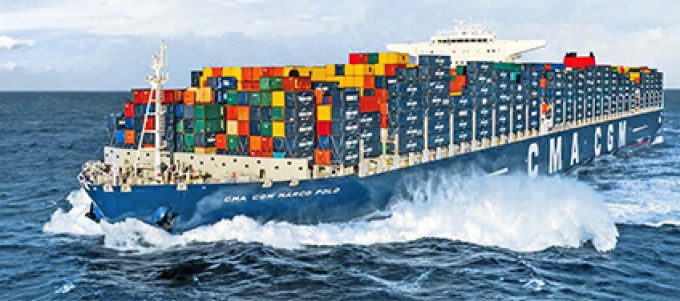
Ocean carriers serving the Asia-Europe tradelanes are looking to capitalise on their end-of-year freight rate gains by announcing more general rate increases (GRI) ahead of the Chinese New Year holiday next month.
CMA CGM said yesterday it would be asking Asian shippers with consignments for North European and Mediterranean destinations for a further $500 per teu from 15 January. The move follows GRIs already announced by other carriers, including MSC and CSCL.
The latest rate restoration campaign by the container lines follows a significant spike in spot rates in the final week of December.
The Shanghai Containerized Freight Index (SCFI) for North Europe surged by $659 per teu, as at 31 December, to $1,232, an increase of 115%, and for the Mediterranean the percentage increase was even higher, at 147%, taking rates up $747 to $1,257 per teu.
According to London container derivatives broker FIS, capacity became an issue just prior to Christmas, resulting in the substantial increase in spot rates – and there are signs that the market strength could continue for a while.
“I think it [the GRI] might hang around a little longer than normal,” said FIS’s Richard Ward. “We were hearing that space was an issue before Christmas, although we know how quickly this can change.”
Mr Ward added that he expected carriers would go for “another big push” prior to the Chinese New Year, which this year falls on 8 February.
It is crucial that carriers succeed in getting as much of their GRI to stick before the holiday, given that cargo demand always falls flat for a period afterwards.
Indeed, in anticipation of that weaker demand, the G6 Alliance has announced it will cancel four of its Asia-North Europe loops in weeks 6 and 7, taking out around 64,000 slots of capacity.
Moreover, in the absence of annual contracts – negotiations for many of which stalled in December against a backcloth of sub-economic ‘market’ rate levels that carriers were not prepared to sign up to for a 12 month period – spot rates are more important to the container lines than in recent years. Hence carriers will do whatever is necessary to tighten supply and attempt to hold onto rate increases, even after the CNY holidays, enabling them to go back to the negotiating table with shippers in a stronger position than before.
But much will depend on the discipline of the carriers in refraining from discounting rates in a race-to-the-bottom quest to fill their newbuild mega-containerships; a quality that has been badly lacking within the industry in the past few years.
Furthermore, the fundamentals of the Asia-Europe tradelanes remain weak and it is difficult to find an economist or analyst that is optimistic about 2016.
In its latest North Europe Trade Outlook, by Global Port Tracker, Ben Hackett, of Hackett Associates, said his firm was taking a “decidedly pessimistic view of the coming six months”.
The report says the North European economy is showing “signs of remaining in the doldrums” and predicts a further decline in volumes in the first half of 2016. It said: “At best we are facing a mild recession, at worst something more severe as capacity continues to sharply outpace demand.”
All of which reiterates the rather gloomy new year messages from the ‘big three’ Japanese shipping groups, NYK, K Line and MOL, with the latter saying that the business climate “remains severe”.
Meanwhile, in terms of the Chinese Zodiac, 2016 is the Year of the Monkey, which from a business prospective offers both good and bad news for carriers: “In this year, they can make a fortune easily, but could also run out of money soon,” says one prediction.

